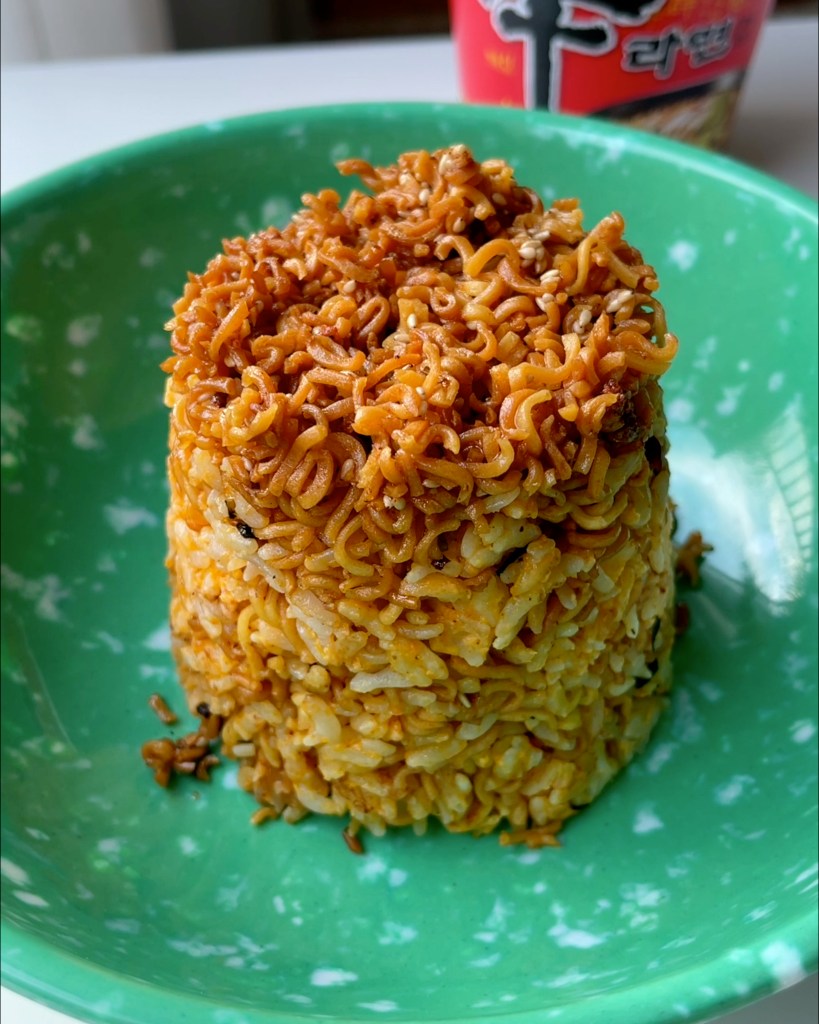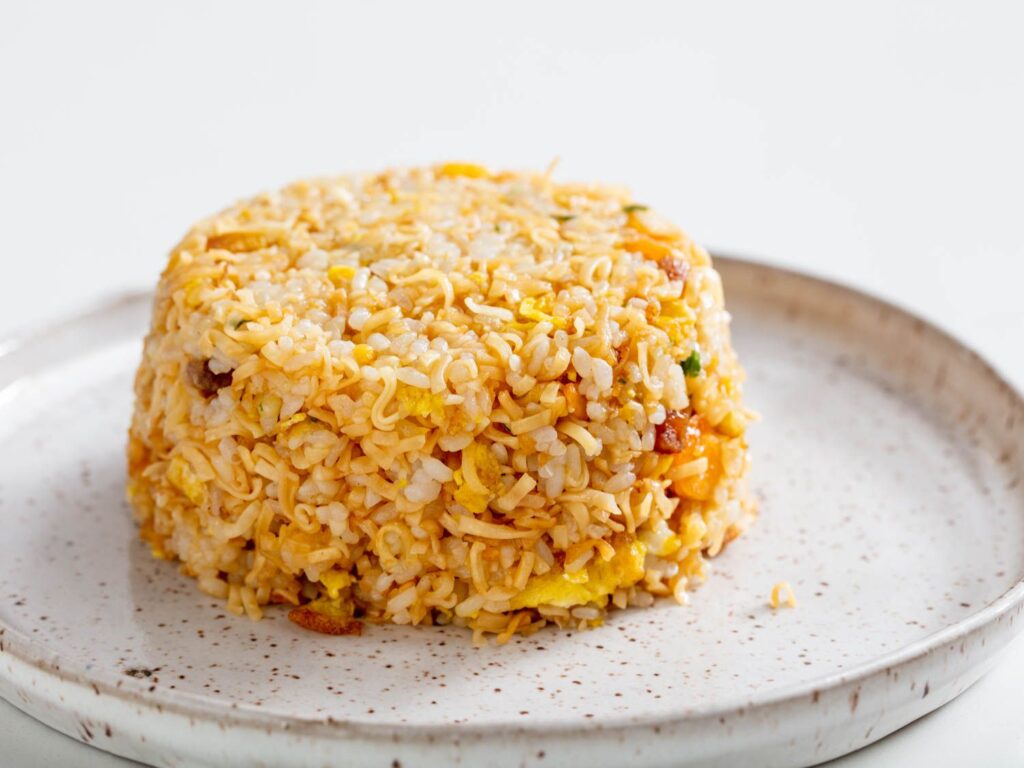Ramen noodles and rice are two beloved staples in many kitchens. Both are versatile, delicious, and easy to prepare.
Ramen noodles and rice have a special place in global cuisine. From quick, comforting meals to gourmet dishes, these ingredients are adaptable and satisfying. Ramen noodles, with their savory broth and toppings, offer a rich, flavorful experience. Rice, on the other hand, serves as the foundation for countless dishes across cultures.
Whether you’re a student seeking a quick meal or a home cook exploring new recipes, ramen noodles and rice provide endless possibilities. Let’s dive into the wonderful world of these two culinary essentials, exploring their uses, flavors, and the joy they bring to our tables.
Introduction To Fusion Cuisine
Fusion cuisine blends different culinary traditions. It creates unique and flavorful dishes. This innovative cooking style often surprises and delights the palate.
Today, we’re diving into a popular fusion combination: ramen noodles and rice. This mix offers an exciting twist on traditional meals. Let’s explore why this blend is gaining popularity.
What Is Fusion Cuisine?
Fusion cuisine combines elements from diverse cultures. It merges techniques, ingredients, and flavors from multiple culinary traditions. This approach leads to inventive and delicious dishes.
Chefs often experiment with fusion cuisine. They mix unexpected ingredients to create new flavors. This results in exciting culinary experiences for diners.
Fusion cuisine is not limited to high-end restaurants. Home cooks also enjoy creating fusion dishes. They blend familiar ingredients in new ways. This trend makes cooking more fun and adventurous.
The Appeal Of Ramen And Rice
Ramen and rice are both beloved staples. Each offers unique textures and flavors. Combining them creates a satisfying and versatile meal.
- Ramen: Chewy noodles with savory broths.
- Rice: Soft grains that absorb flavors.
When combined, these ingredients complement each other. The noodles add a hearty texture. The rice balances the dish with a soft bite. Together, they create a harmonious blend of flavors and textures.
Fusion dishes like ramen and rice appeal to many people. They offer the best of both worlds. This combination is perfect for those who love exploring new taste experiences.
Here are some popular ways to enjoy ramen and rice together:
- Ramen rice bowls
- Ramen fried rice
- Ramen and rice soup
These dishes are easy to prepare. They offer a variety of flavors and textures. This makes them a popular choice for many home cooks and food enthusiasts.
Essential Ingredients
Ramen noodles and rice are staple foods in many cuisines. Both dishes rely on specific ingredients to achieve their unique flavors. Understanding these essential components can elevate your cooking.
Key Components For Ramen
Ramen noodles need fresh ingredients to taste authentic. Here are some key components:
- Noodles: Fresh or dried, the texture is crucial.
- Broth: The soul of ramen. Pork, chicken, or vegetable.
- Meats: Common choices are pork belly, chicken, or beef.
- Vegetables: Scallions, mushrooms, and bamboo shoots.
- Seasonings: Soy sauce, miso, and salt for flavor.
- Toppings: Soft-boiled eggs, nori, and sesame seeds.
Staples For Rice Dishes
Rice dishes have their own set of essentials. Here are the staples:
- Rice: Jasmine, basmati, or sushi rice, depending on the dish.
- Proteins: Chicken, beef, tofu, or seafood.
- Vegetables: Carrots, peas, and bell peppers.
- Seasonings: Soy sauce, fish sauce, and curry powder.
- Garnishes: Fresh herbs like cilantro and green onions.
| Ramen Key Components | Rice Dish Staples |
|---|---|
| Noodles | Rice |
| Broth | Proteins |
| Meats | Vegetables |
| Vegetables | Seasonings |
| Seasonings | Garnishes |
| Toppings |
Ramen Noodle Stir-fry
Ramen Noodle Stir-Fry is a quick and tasty dish. It combines the ease of ramen noodles with the fresh flavors of vegetables and sauces. This dish is perfect for a fast weeknight meal or a fun weekend dinner. Let’s dive into the details.
Ingredients Needed
To make a delicious Ramen Noodle Stir-Fry, you will need the following ingredients:
| Ingredient | Quantity |
|---|---|
| Ramen Noodles | 2 packs |
| Vegetable Oil | 2 tablespoons |
| Garlic (minced) | 2 cloves |
| Mixed Vegetables (carrots, bell peppers, broccoli) | 2 cups |
| Soy Sauce | 3 tablespoons |
| Oyster Sauce | 2 tablespoons |
| Green Onions (chopped) | 2 |
| Sesame Seeds | 1 tablespoon |
Step-by-step Instructions
- Start by cooking the ramen noodles according to the package instructions. Drain and set aside.
- Heat the vegetable oil in a large pan over medium-high heat.
- Add the minced garlic and cook until fragrant, about 1 minute.
- Stir in the mixed vegetables. Cook for 5-7 minutes until they are tender but still crisp.
- Add the cooked ramen noodles to the pan. Toss to combine with the vegetables.
- Pour in the soy sauce and oyster sauce. Mix well to coat everything evenly.
- Cook for an additional 2-3 minutes, stirring frequently.
- Remove from heat and sprinkle with chopped green onions and sesame seeds.
- Serve hot and enjoy your delicious Ramen Noodle Stir-Fry!

Credit: www.amazon.com
Rice-based Sushi Burritos
Rice-Based Sushi Burritos are a delightful fusion of Japanese and Mexican cuisines. These burritos offer a unique way to enjoy sushi. They combine the flavors of sushi with the convenience of a burrito. The result is a portable, fun, and tasty meal. Let’s dive into how to make these delicious creations at home.
How To Prepare Rice
The first step in making sushi burritos is preparing the rice. You will need sushi rice, which is short-grain rice. Follow these steps:
- Rinse the rice until the water runs clear.
- Cook the rice according to the package instructions.
- Mix rice vinegar, sugar, and salt in a bowl.
- Once the rice is cooked, mix in the vinegar solution.
- Let the rice cool to room temperature.
Properly prepared rice is crucial for a good sushi burrito. It should be sticky but not mushy.
Filling And Rolling Techniques
Next, choose your fillings. Popular options include:
- Fresh fish like tuna or salmon
- Crab meat or imitation crab
- Vegetables like cucumber, avocado, and carrots
- Pickled ginger and wasabi for added flavor
Lay out a sheet of nori (seaweed) on a bamboo mat. Spread an even layer of rice over the nori, leaving a border at the top.
Add your chosen fillings in a line across the center of the rice. Use the bamboo mat to roll the sushi tightly. Press firmly but gently.
Finally, cut the roll into halves or quarters. Now, your sushi burrito is ready to enjoy.
For a visual guide, refer to the table below:
| Step | Description |
|---|---|
| 1 | Prepare the rice |
| 2 | Choose fillings |
| 3 | Lay out nori and rice |
| 4 | Add fillings |
| 5 | Roll and cut |
Enjoy your homemade Rice-Based Sushi Burritos. They are perfect for a quick meal or a fun gathering with friends.
Ramen Noodle Soups
Ramen noodle soups are a beloved dish worldwide. They offer comfort and flavor in every spoonful. These soups come in countless varieties, each with its own unique taste and ingredients. Let’s explore the magic of ramen noodle soups.
Broth Varieties
The broth is the soul of ramen noodle soup. It defines the flavor profile. Here are some common types:
- Tonkotsu – A rich, creamy pork bone broth.
- Shoyu – Soy sauce-based, clear and savory.
- Miso – Fermented soybean paste, thick and hearty.
- Shio – Salt-based, light and delicate.
Each broth brings a unique taste to the table. Experiment with different broths to find your favorite.
Toppings And Garnishes
Toppings enhance the ramen experience. They add texture and extra flavors. Popular choices include:
- Chashu – Slices of braised pork belly.
- Nori – Sheets of dried seaweed.
- Menma – Fermented bamboo shoots.
- Scallions – Freshly chopped green onions.
- Soft-Boiled Eggs – Marinated in soy sauce for extra flavor.
Garnishes can also include sesame seeds, chili oil, and pickled ginger. These add finishing touches to your bowl.
Here is a table summarizing the popular broth varieties and toppings:
| Broth Variety | Description |
|---|---|
| Tonkotsu | Rich, creamy pork bone broth |
| Shoyu | Soy sauce-based, clear and savory |
| Miso | Fermented soybean paste, thick and hearty |
| Shio | Salt-based, light and delicate |
| Topping | Description |
|---|---|
| Chashu | Slices of braised pork belly |
| Nori | Sheets of dried seaweed |
| Menma | Fermented bamboo shoots |
| Scallions | Freshly chopped green onions |
| Soft-Boiled Eggs | Marinated in soy sauce for extra flavor |

Credit: doobydobap.com
Rice Bowls With Ramen Toppings
Rice bowls with ramen toppings offer a delightful fusion. They blend the hearty comfort of rice with the exciting flavors of ramen. This creative twist on traditional dishes promises a satisfying meal that’s both versatile and delicious.
Perfecting The Rice
The foundation of any good rice bowl is perfectly cooked rice. Start with high-quality short-grain rice. Rinse it thoroughly under cold water to remove excess starch. This ensures a fluffy texture.
Use a 1:1.2 ratio of rice to water. For one cup of rice, use 1.2 cups of water. Bring the water to a boil. Then reduce the heat and simmer for about 20 minutes. Let it sit covered for another 10 minutes. Fluff with a fork before serving.
Creative Topping Ideas
The fun part is choosing the toppings. Here are some ideas to get you started:
- Chashu Pork: Tender slices of braised pork belly.
- Soft-Boiled Egg: Perfectly cooked eggs with a creamy yolk.
- Nori: Dried seaweed adds a salty, umami flavor.
- Scallions: Fresh and crunchy for a burst of flavor.
- Bamboo Shoots: Adds a nice texture and subtle sweetness.
- Pickled Ginger: For a tangy, zesty kick.
- Corn: Adds sweetness and a pop of color.
For a vegetarian option, consider these toppings:
- Marinated Tofu: A protein-packed alternative to meat.
- Edamame: Nutritious and adds a nice crunch.
- Mushrooms: Sautéed or marinated for a rich umami flavor.
- Spinach: Lightly blanched for a fresh, green touch.
- Carrots: Julienne for a sweet and crunchy bite.
Mix and match these toppings to create your perfect rice bowl. The possibilities are endless!
Fusion Desserts
When it comes to fusion desserts, the combination of ramen noodles and rice can create delightful surprises. These unique treats blend the savory essence of traditional dishes with the sweet indulgence of desserts. Explore the possibilities with these innovative ideas.
Sweet Ramen Treats
Sweet ramen treats might sound unusual, but they are a delightful surprise. By pairing ramen noodles with sweet ingredients, you can create a unique dessert.
- Ramen Pudding: Cook ramen noodles until soft. Mix with milk, sugar, and vanilla. Chill and serve with a sprinkle of cinnamon.
- Chocolate Ramen: Melt chocolate and coat cooked ramen noodles. Let it set and enjoy a crunchy treat.
- Ramen Ice Cream: Fold cooked and chilled ramen into your favorite ice cream. Add toppings like nuts or fruits for extra flavor.
Rice Pudding Variations
Rice pudding is a beloved dessert in many cultures. Adding different flavors and ingredients can make it even more exciting.
- Coconut Rice Pudding: Use coconut milk instead of regular milk. Add shredded coconut and top with mango slices.
- Matcha Rice Pudding: Mix matcha powder into the pudding. Serve with a dollop of whipped cream and a sprinkle of green tea powder.
- Chocolate Rice Pudding: Add cocoa powder and chocolate chips to the pudding. Garnish with chocolate shavings.
These fusion desserts are not only delicious but also easy to make. They bring a twist to traditional flavors and offer a fresh take on dessert-making. Experiment and enjoy these creative combinations!

Credit: doobydobap.com
Tips And Tricks
Ramen noodles and rice are staple dishes in many homes. They are versatile, quick to prepare, and satisfying. Here are some tips and tricks to make your ramen noodles and rice dishes even better.
Cooking Techniques
Cooking ramen noodles and rice to perfection requires some simple techniques. Follow these steps to achieve the best results:
- For ramen noodles, boil water first. Add noodles after water boils.
- Cook noodles for 3-4 minutes. Stir occasionally to avoid sticking.
- For rice, rinse until water runs clear. This removes excess starch.
- Use a 1:1.5 ratio of rice to water. Adjust for softer rice.
- Simmer rice on low heat. Cover the pot and cook for 18-20 minutes.
Balancing Flavors
Balancing flavors is key to a delicious dish. Here are some tips to enhance the taste of your ramen noodles and rice:
- Use soy sauce, miso paste, or fish sauce for umami flavor.
- Add ginger, garlic, and green onions for a fragrant boost.
- Include vegetables like carrots, bell peppers, or spinach.
- Top with a soft-boiled egg or grilled chicken for protein.
- Finish with sesame oil or chili oil for added depth.
| Ingredient | Flavor Profile | Usage |
|---|---|---|
| Soy Sauce | Salty, Umami | Use in broth or stir-fry |
| Garlic | Pungent, Aromatic | Add to hot oil or broth |
| Sesame Oil | Nutty, Rich | Drizzle over finished dish |
Experiment with different ingredients and techniques. This will help you find what you like best. Enjoy your cooking!
Frequently Asked Questions
What Are Ramen Noodles Made Of?
Ramen noodles are primarily made from wheat flour, water, salt, and kansui. Kansui is an alkaline mineral water that gives ramen its unique texture.
How Do You Cook Ramen Noodles?
To cook ramen noodles, boil them in water for 3-5 minutes. Drain the water and add your preferred seasoning or broth.
Are Ramen Noodles Healthy?
Ramen noodles can be high in sodium and lack essential nutrients. Opt for homemade or low-sodium versions with added vegetables and protein for a healthier option.
What Types Of Rice Are Used In Cooking?
Common types of rice include white rice, brown rice, jasmine rice, and basmati rice. Each type has unique flavors and textures.
Conclusion
Ramen noodles and rice each offer unique tastes and benefits. Both are versatile, easy to prepare, and can be part of many dishes. Whether you prefer ramen’s savory broth or rice’s simplicity, both options can fit into any meal plan.
Enjoy exploring different recipes and find what suits your taste. Remember, balance and variety keep meals exciting and nutritious. Enjoy your culinary adventures with ramen and rice!




